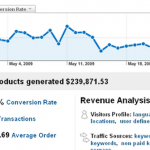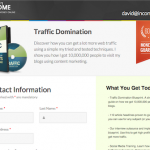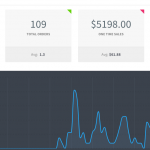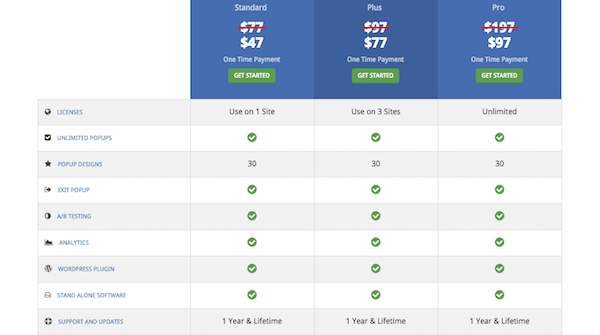
Consultants, how much does it cost to work with you?
If you sell your services at a single set price, get prepared, because your business is about to level up.
It’s no secret the most successful companies give a variety of options to appeal to a broad spectrum of customer’s financial situations.
But what you may not realize is those price points are planned to subconsciously direct people to spend a set amount, whether they realize it or not.
At a spa, there’s a wide range of services between the 15 minute facial or the all day relaxation package.
You’re not just stuck with the option of lawn seats or VIP passes at a concert.
And many consultants, don’t just limit their services to the one hour phone call, or the $30,000 full-service training package.
Multiple price points with benefits and add-ons at each tier gives your client more options, and if you’re strategic about your price points, you can very easily guess what the majority of people are going to go for.
Secret #1: Use Tiered Pricing to Play Ego against Logic.
Imagine for a moment you are considering buying SEO software.
You plan to blog regularly. Perhaps every day, at the very least a few times per week, and this software promises to boost your blog’s visibility by evaluating your articles for keywords, and give suggestions to improve your Google ranking.
You know you will use it at least a few times per week, and are estimating you’ll spend between $35 and $45 for it.
A click later, you see that the pricing options are:
Which do you choose?
If you said “professional,” well done. You did exactly what they wanted you to do.
Now despite the landing page design being very pointed in where you should click, you would have likely came to the same decision (the design just got you there sooner)
Why?
Their multi-tiered pricing creates a war in your brain between your primal instinct and your logical response to options.
The logical response says, “I’m one person… I clearly won’t need 300 evaluations a month. That’s far too much.”
But the primal instinct says, “I need more than the bare minimum to survive. I’m going to grow. I’ll need more next week. I need to stockpile, to prepare, ‘just enough’ won’t be enough.”
So why does simply offering more options create this response?
Because with a single price point a purchase decision can be either accepted or dismissed with a simple“yes” or “no.”
But when you bookend the choices, suddenly your customer is involved, however briefly, in imagining different scenarios for each level of ownership.
They start thinking, “What if the cheapest option isn’t enough?” They start seeing themselves as being unprepared because they bought the lowest-priced item.
Others are more optimistic.
They envision themselves achieving more and therefore justify paying more. They see themselves becoming more successful because they haven’t limited themselves to “just enough,” have room to move and grow.
Either way, the purchase has drama and more emotional investment when there are a limited set of options.
You can create these same subconscious, survival-based thought patterns in your clients by switching your pricing from a single option to offering different levels of pricing for your services.
Switching to a variety of options vs. a single price point is the first and most important step in guaranteeing more purchases.
Secret #2: Give A Lot More for Slightly More Money.
To the majority of people, the two central options will be where their attention focuses immediately.
For these groups, the highest and lowest prices are briefly considered and immediately dismissed as being “too much” and “not enough,” which means the battle is in choosing between the the lower-middle and the higher-middle pricing options.
These folks spend the most amount of time on their purchase.
They take the time to time debate the pros and cons of spending the extra few dollars per month, or per level, so set pricing to make it simple for them.
Do so by offering a value multiple times higher than in the lower-priced option, without changing the price by the same ratio.
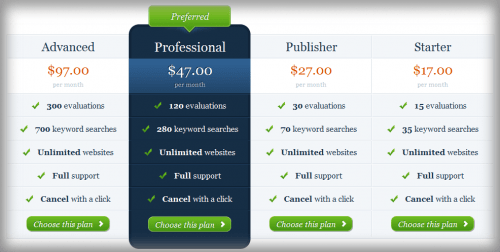
Back to our SEO example, by purchasing the Professional package for $47 per month, a customer will receive four times as many evaluations as they would for the next option down, the Publisher.
But the Professional price is not the Publisher price, quadrupled.
Instead, it’s not even doubled. It’s an affordable step up with an immense added benefit.
Make it painfully, starkly clear that the higher-midrange price is where the really good deal is found.
Logic will win out in nearly all cases, as clients justify to themselves the great bargain they just got by buying from you.
Secret #3: There’s always someone who only buys the best.
We all know someone who enjoys spending money.
It’s more than a necessity, it’s a symbol of their self-esteem. When it comes down to it, money equals status and self importance, and that matters a great deal to a large percentage of business people.
You may never know it, but even Joe Handyman in the flannel shirt is saving his dollars for the creme de la creme of cars, tools, and blueprints.
Some folks who are pennypinchers at home will indulge on their business, because their work is their passion, and that is how they justify high-cost items.
Your highest price point should be something that seems indulgent.
The folks who want the best, who gauge value based on cost, won’t take you seriously if “just anyone” could afford it.
They are out there, and some have already passed you by.
It’s all about the implications made by their purchase, and because they feel that more money means better quality, and they want only the best.
In your pricing structure, include a best-of-the-best, enterprise-level price point and you will convey the sense that you and your services are more than worth their time.
On the flip side, you want your lowest price to be reasonable, profitable for your company and helpful to your clients, but ultimately not a huge gamble on their part.
Thrifty clients want to feel that if their investment is a total waste of money, they haven’t lost too much. They want to get just enough because they plan to be frugal with their usage and get every bit of functionality or information from you or your product that they can.
Bonus Secret: It’s not that difficult.
Offering your services on a tiered price structure isn’t as difficult as you think.
Consider what it would take for you to go above and beyond all expectations, I mean everything you do and roll that up into one bundle to create your highest price point. Remember: it should offset a considerable amount from your next highest price point.
From there, take out the additional services that go above and beyond, leaving a really good option. This will be your third highest pricepoint, and likely what the majority of your business will be.
Then for the last two subtract services until you are left with just the very basic service at the bottom.
For Example: Let’s say you design websites, your structure could look something like:
(From MenswithPens.ca)
| WordPress website including optional integrated blog | |||
| Custom-designed business logo | |||
| Customized social media section in sidebar | |||
| Attention-grabbing opt-in/sign-up section on website | |||
| Custom-designed Twitter page to impress followers | |||
| Custom-designed Facebook page that fans will love | |||
| Custom-designed newsletter design to stay in touch with readers | |||
| 5 pages of copywriting for your website pages (Home, About and three pages of your choice) | |||
| 25-page ebook: Full design AND content custom-written based on your outline and notes | |||
| Members-only site-matching forum. Great for courses and community building! | |||
| Professional site-matching business card design | |||
| Retail Rate | $4,999 | $6,799 | $12,999 |
Of course, there is no “Copper” package, but it’s easy to see how a simple wordpress setup could be the bottom tier option in this scenario.
A final word of caution: when factoring in the different values per cost, do not make the disparities so clear that one group or another feels taken advantage of. Your product or your service must be justifiably worth the cost, at any level.
Your turn…
How can you use a tiered price structure in your own business? What services do you offer right now that you might be undercharging for?




